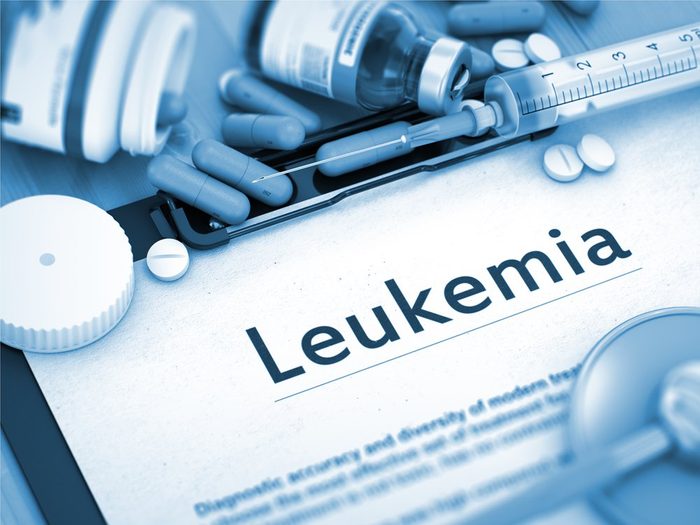
What is leukemia?
Leukemia is a cancer that starts in blood stem cells, according to the Canadian Cancer Society. As the stem cells of the blood develop, they become blast cells (blasts), which are immature blood cells. In Leukemia there’s an overproduction of blast cells and they never mature. Over time, these blast cells crowd out the healthy blood cells so they can’t do their job. As the unhealthy blood cells crowd out healthy ones, blood function begins to falter and you may notice physical symptoms. The disease may get worse quickly if you have a type known as acute leukemia; the disease may progress slowly and get worse over time if you have chronic leukemia.
Regardless of which type you have, if you notice a collection of these subtle signs of leukemia, see your health care provider for an evaluation.

Fatigue and weakness
Fatigue and weakness are the most common signs of leukemia, according to Mark Levis, MD, PhD, the director of the leukemia program at the Johns Hopkins Sidney Kimmel Comprehensive Cancer Center. These signs are often caused by anemia (a deficiency of red blood cells), which only compounds the physical exhaustion.
In both chronic and acute cases, you may experience a range from slight fatigue to extreme physical weakness, but in all cases, the symptoms only worsen over time. “It creeps up on people, that’s the problem,” says Dr. Levis.
Before you get too worried, know this: Leukemia isn’t as common as you might think. These are the 10 most common cancers in Canada.
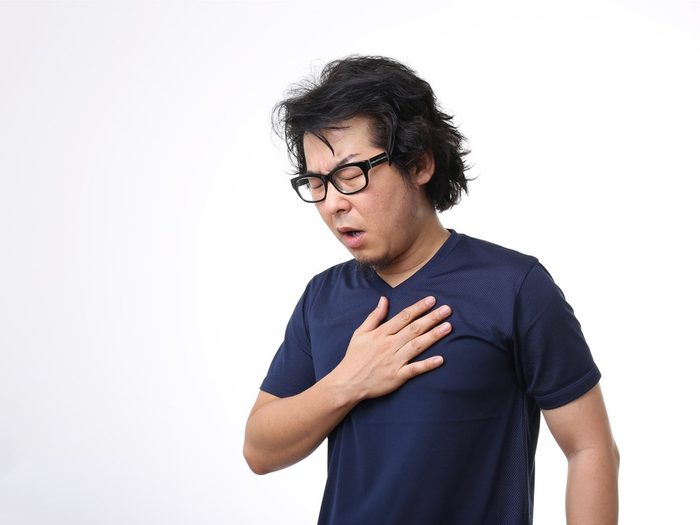
Shortness of breath
As patients grow weaker and more fatigued, they may also experience shortness of breath that stems from anemia or, in much rarer cases, masses in the chest. “They’re panting, they’re out of breath,” says Dr. Levis. “Walking across the room might be difficult.” Shortness of breath can also be a symptom of lung cancer. Here are 13 things to know if you have a lung nodule.
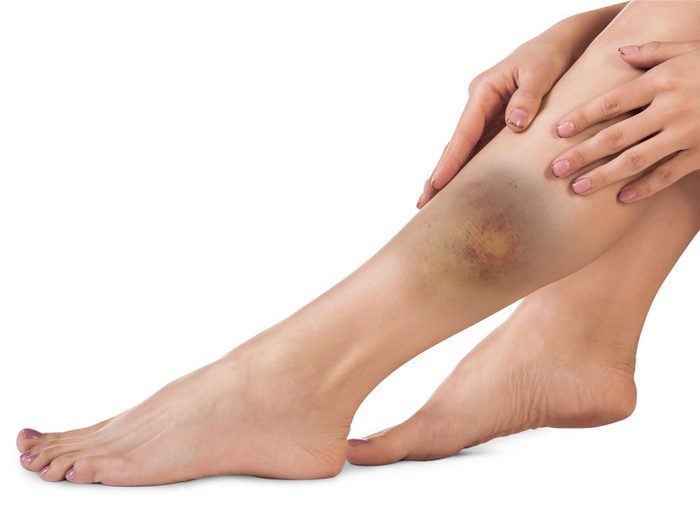
Excessive or spontaneous bruising
Unexplained bruises without any physical trauma may be a sign of leukemia, according to Pamela Crilley, DO, chair of the department of medical oncology at the Cancer Treatment Centers of America and chief of medical oncology at the Eastern Regional Medical Center. Unusual bruising is a result of a low platelet count or clotting issues, explains Dr. Levis. “You will bruise spontaneously, seemingly doing nothing,” he says. “It can be anywhere, but typically they’ll be on the extremities—legs and arms.” And here’s what the colour of your bruise means.

Unusual bleeding
Similar to bruising, unusual nosebleeds or bleeding in the gums, bowels, lungs, or the head may be a sign of platelet deficiency and clotting problems, which can indicate acute forms of leukemia, says Dr. Crilley.
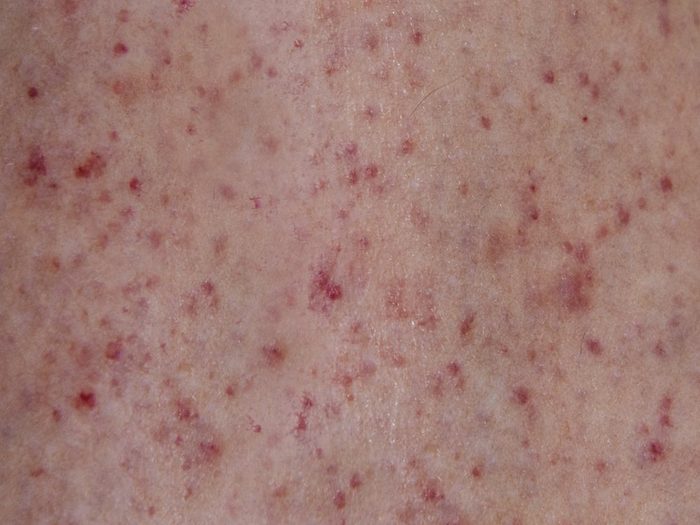
Petechiae (small red spots under the skin caused by bleeding)
Dr. Crilley describes petechiae as: “like someone painted little red dots with a pen.” The spots, which you might not notice because of their size, painlessness, and placement in the lower extremities, indicate a low platelet count. According to Dr. Levis, petechiae are typically found around the ankles because gravity results in the accumulation of bodily fluids in the lower legs throughout the day.
This is the biggest factor that causes your body to deteriorate as you age.
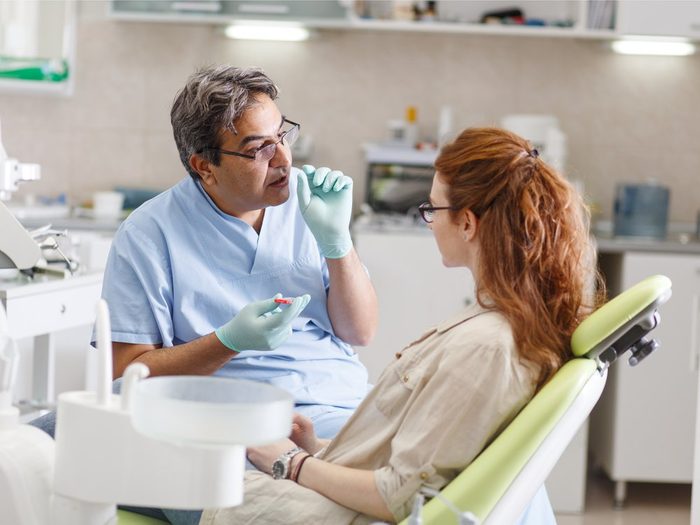
Swollen and enlarged gums
Although an increase in the size of the gums, also known as gingival hyperplasia, is usually only found in a small portion of acute leukemia patients, it’s one of the most obvious signs of the disease. “If you have a patient with leukemia, you always look in their mouth to see if the gingiva has gotten bigger,” says Dr. Crilley. The gum may look swollen, says Dr. Levis, and you nearly always feels a strange tightness in your mouth.
Don’t miss these 14 signs you could be a hypochondriac.

Feeling full or bloated
One sign of chronic—and sometimes acute—types of leukemia is an enlarged spleen, which may result in a loss of appetite. You might have what’s called “early satiety,” according to Dr. Crilley. “Patients eat a little bit of food, they feel full quickly because the spleen is pushing up on the stomach,” she says. Here are 11 things doctors can tell just by looking at you.
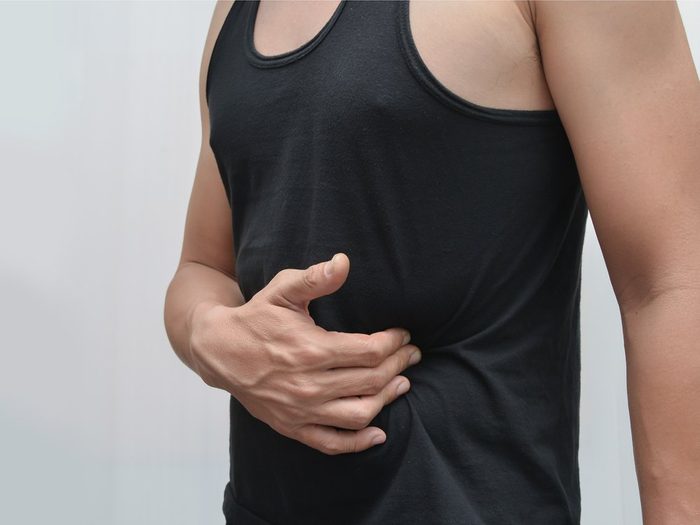
Discomfort or pain in the upper left abdomen
An enlarged spleen caused by leukemia sometimes results in abdominal discomfort or even sharp pain. “A patient that presented to me with chronic leukemia a few weeks ago, part of his spleen had died off from spleen enlargement,” says Dr. Levis. “It hurt like heck. It was a sharp pain in his abdomen.” Because the spleen is located in the upper-left quadrant of the abdomen, the discomfort usually occurs there. Here’s why type O is the most common blood type.

Fever or chills
Feverishness or chills are not the most common symptoms, typically only occurring in a quarter of acute leukemia cases and almost never in chronic leukemia cases, according to Dr. Levis. More often, frequent low-grade fevers indicate an infection and a weakened immune system, which may also be related to leukemia. This is what happens to your body when you have a fever.
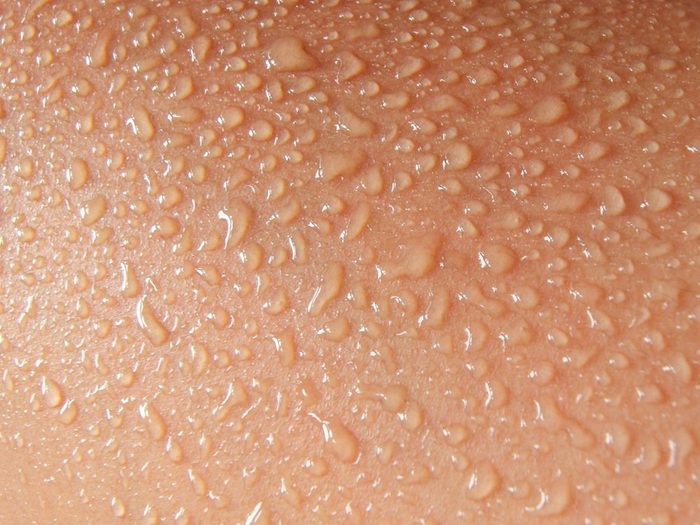
Night sweats
Night sweats are often caused by infections that may be linked to leukemia. “You’re just drenched, and the sheets are drenched,” says Dr. Crilley. “Something like that needs to be investigated.” Here, survivors explain what chemotherapy is really like.

Pounding headaches
Although not common, frequent pounding headaches may be a sign of leukemia-related anemia or even a life-threatening case of bleeding in the head.
Are your odds of developing cancer really 50/50? Here’s what you need to know about your cancer risk.

Extreme pallor
Like headaches, fatigue, and shortness of breath, unusual paleness may be a sign of anemia in acute and some chronic leukemia patients. “If they’re looking pretty pale, they’re already pretty advanced and pretty sick,” says Dr. Levis. “They’re almost always extremely fatigued. If your red blood cell level is low enough to be pale, you’re panting when you go across the room.”
Here are 10 things doctors secretly wish they could tell you.

Bone pain
Achiness in the bones is a relatively uncommon but often clear symptom of both chronic and acute types of leukemia, according to Dr. Levis. Leukemic cells are made inside the bone marrow, so if you feel anything from mild achiness to extreme pain in your bones, it’s best for you to seek medical attention.

Swollen lymph nodes
Check your neck, armpit, and groin areas for noticeable but painless swelling in your lymph nodes. It’s normal for the glands to go up and down in size during periods of infection, but if they stay enlarged or keep growing, that may be a sign of leukemia or lymphoma, says Dr. Crilley.
Looking to reduce your risk? Adding this veggie to your diet could help slash your risk of developing cancer.
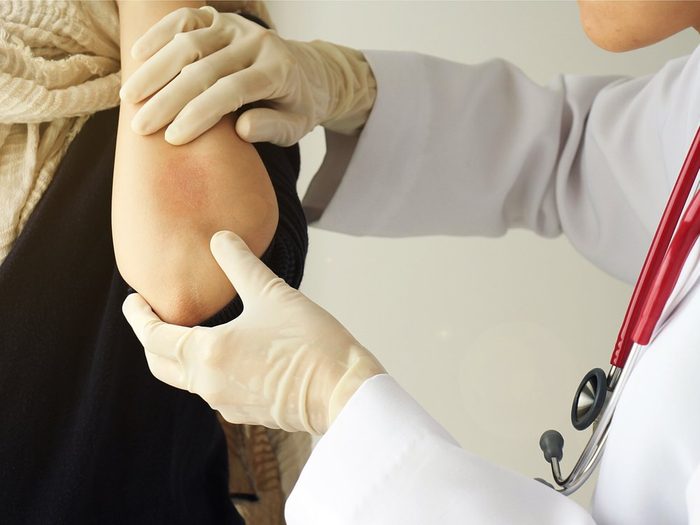
A skin rash
Approximately one in 20 leukemia patients may have a skin rash that falls into one of two categories: a leukemia of the skin, or a rash caused by Sweet’s syndrome, which is commonly associated with leukemia, according to Dr. Levis. “Leukemia of the skin almost always looks like your skin has a lump inserted inside it,” he says. “A little mound starts growing. Occasionally it can be a plaque-like thing.” Sweet’s syndrome rashes, on the other hand, appear red and angry, similar to an allergic reaction. But although skin rashes come in all shapes and sizes, leukemia-related rashes have one thing in common: they will continue to grow and spread.

Frequent or recurring infections
If you have that one small infection that just won’t go away, no matter how many antibiotics your physician prescribes, it may be time to get a complete blood count to check for abnormalities in your white blood cell, hemoglobin, and platelet levels. Abnormal white blood cell levels lead to an impaired immune system, which could explain frequent infections and the feeling of always being on the verge of the flu or infection. That, coupled with other signs such as fatigue or bruising, should be enough to send you to the doctor.
“Leukemia is always a surprise; it sneaks up on you,” says Dr. Levis. Because leukemia patients can be asymptomatic or display symptoms that are common to other illnesses, it’s important to get a physical examination, blood count, and bone marrow biopsy, which will characterize the exact type of leukemia and dictate the necessary treatment.
Where do you live? These are the Canadian provinces with the highest rate of cancer.
